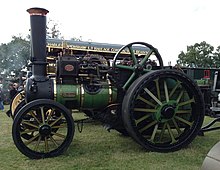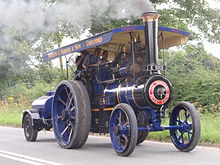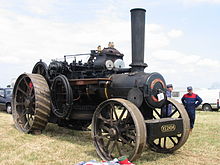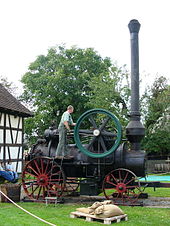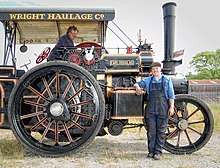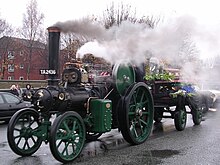
A locomotive or engine is a rail transport vehicle that provides the motive power for a train. If a locomotive is capable of carrying a payload, it is usually rather referred to as a multiple unit, motor coach, railcar or power car; the use of these self-propelled vehicles is increasingly common for passenger trains, but rare for freight trains.

Continuous track or tracked treads are a system of vehicle propulsion used in tracked vehicles, running on a continuous band of treads or track plates driven by two or more wheels. The large surface area of the tracks distributes the weight of the vehicle better than steel or rubber tyres on an equivalent vehicle, enabling continuous tracked vehicles to traverse soft ground with less likelihood of becoming stuck due to sinking.

A tractor is an engineering vehicle specifically designed to deliver a high tractive effort at slow speeds, for the purposes of hauling a trailer or machinery such as that used in agriculture, mining or construction. Most commonly, the term is used to describe a farm vehicle that provides the power and traction to mechanize agricultural tasks, especially tillage, and now many more. Agricultural implements may be towed behind or mounted on the tractor, and the tractor may also provide a source of power if the implement is mechanised.

A tank locomotive or tank engine is a steam locomotive which carries its water in one or more on-board water tanks, instead of a more traditional tender. Most tank engines also have bunkers to hold fuel; in a tender-tank locomotive a tender holds some or all of the fuel, and may hold some water also.

A steamroller is a form of road roller – a type of heavy construction machinery used for leveling surfaces, such as roads or airfields – that is powered by a steam engine. The leveling/flattening action is achieved through a combination of the size and weight of the vehicle and the rolls: the smooth wheels and the large cylinder or drum fitted in place of treaded road wheels.

Under the Whyte notation for the classification of steam locomotives, 4-2-0 represents the wheel arrangement of four leading wheels on two axles, two powered driving wheels on one axle and no trailing wheels. This type of locomotive is often called a Jervis type, the name of the original designer.
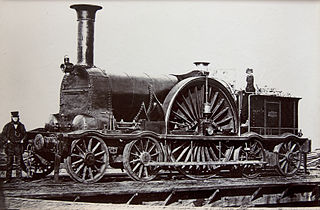
Under the Whyte notation for the classification of steam locomotives, 4-2-4 represents the wheel arrangement of four leading wheels on two axles, two powered driving wheels on one axle, and four trailing wheels on two axles.

Aveling and Porter was a British agricultural engine and steamroller manufacturer. Thomas Aveling and Richard Thomas Porter entered into partnership in 1862, and developed a steam engine three years later in 1865. By the early 1900s, the company had become the largest manufacturer of steamrollers in the world. The company used a rampant horse as its logo derived from the White Horse of Kent.

A steam tractor is a tractor powered by a steam engine which is used for pulling.

The Great Dorset Steam Fair is an annual show featuring steam-powered vehicles and machinery held in Dorset, England. It now covers 600 acres (2.4 km2) and runs for five days. This used to be from the Wednesday after the UK August bank holiday, but from 2016 has been from the Thursday before the Bank Holiday until the Bank Holiday itself. It is reputedly the largest collection of steam and vintage equipment to be seen anywhere in the world.
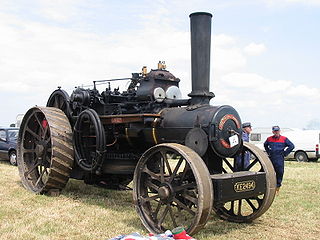
John Fowler & Co Engineers of Leathley Road, Hunslet, Leeds, West Yorkshire, England produced traction engines and ploughing implements and equipment, as well as railway equipment. Fowler also produced the Track Marshall tractor which was a tracked version of the Field Marshall. British Railways Engineering Department locomotives ED1 to ED7 were built by Fowler

A portable engine is an engine, either a steam engine or an internal combustion engine, that sits in one place while operating, but is portable and thus can be easily moved from one work site to another. Mounted on wheels or skids, it is either towed to the work site or moves there via self-propulsion.
The Best Manufacturing Company of San Leandro, California was a manufacturer of farm machinery, known for its steam tractors.
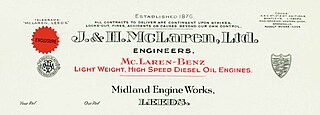
J&H McLaren was a British engineering company in Hunslet, Leeds, England, that manufactured traction engines, stationary engines and later, diesel engines.

Charles Burrell & Sons were builders of steam traction engines, agricultural machinery, steam lorries and steam tram engines. The company were based in Thetford, Norfolk and operated from the St Nicholas works on Minstergate and St Nicholas Street, some of which survives today.
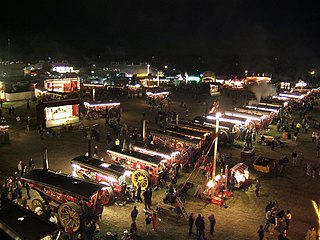
A showman's road locomotive or showman's engine is a steam-powered road-going 'locomotive' designed to provide power and transport for a travelling funfair or circus. Similar to other road-going traction engines, showman's engines were normally distinguished by the addition of a full-length canopy, a dynamo mounted in front of the chimney, and brightly coloured paintwork with ornate decorations. The dynamo was used to generate electricity to illuminate and power various fairground rides. Although originally the ride's motion was powered by an internal steam engine, some later rides were driven direct from the showman's engine via a belt drive.

The history of steam road vehicles comprises the development of vehicles powered by a steam engine for use on land and independent of rails, whether for conventional road use, such as the steam car and steam waggon, or for agricultural or heavy haulage work, such as the traction engine.

A steam wagon is a steam-powered truck for carrying freight. It was the earliest form of lorry (truck) and came in two basic forms: overtype and undertype, the distinction being the position of the engine relative to the boiler. Manufacturers tended to concentrate on one form or the other.
A cannon bearing or cannon box bearing is an arrangement of bearings on a shaft, usually an axle, where two bearings are mounted in an enclosed tube.
The John Fowler 7nhp Steam Road Locomotive is a heritage-listed former steam road locomotive with nominal power of 5.2 kilowatts (7 hp) and now exhibited at 9 Amaroo Drive, Wellington, in the Dubbo Regional Council local government area of New South Wales, Australia. It was designed and built by John Fowler & Co. (Leeds) Ltd in 1912. The property is owned by the Dubbo Regional Council and it was added to the New South Wales State Heritage Register on 18 November 2011.

